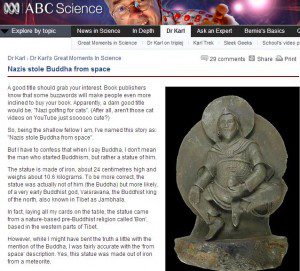Last month Nicholas Kristof provided a timely test of our religious literacy. It started out:
Noah of Arc and his wife, Joan, build a boat to survive a great flood. Moses climbs Mount Cyanide and receives 10 enumerated commandments; for all the differences among religious denominations, the Ten Commandments are a common bedrock that Jews, Catholics and Protestants agree on…

After two or three paragraphs, Kristof tells us that there are about 20 mistakes. He uses the test to explain the general ignorance most Americans have about religion. The reasons for this ignorance are many, but one, unfortunately, is the media. Case in point: the Australian Broadcasting Company’s latest Science article: Nazis stole Buddha from space.
Whether they realize it or not, they’ve replicated Kristof’s quiz with statements like:
well, the title for starters which is then qualified and re-qualified because:
A good title should grab your interest. Book publishers know that some buzzwords will make people even more inclined to buy your book. Apparently, a darn good title would be, “Nazi golfing for cats”. (After all, aren’t those cat videos on YouTube just soooooo cute?)
Note to self: always be wary of a “science” article that begins with an explanation of buzzwords. You can even have the article read to you.
Our “science” author continues to qualify: “To be more correct, the statue was actually not of him (the Buddha) but more likely, of a very early Buddhist god, Vaisravana, the Buddhist king of the north, also known in Tibet as Jambhala.”
I’ll pause here to note that the whole controversy was thoroughly and brilliantly debunked by Buddhism scholar Achim Bayer in 2012 when the story first appeared. You can read his full article for free here (.pdf). It is worth reading not only for the clear and detailed discussion of the statue, but also for the reflections on academic responsibility.
Suffice to say that the statue is a fake, most likely created by a European sculptor in the 20th century. An image of Vaiśravaṇa might have influenced the process, but aspects of Padmasambhava also shine through. However, several details, including the trousers, shoes, and beard notably resemble European features more than anything in Tibetan Buddhism.
It’s unfortunate that the original story, so poorly fact-checked by the media, went so viral when it did. And it’s downright puzzling that it should be picked up again, nearly 18 months after the whole thing made the rounds in the first place. Buried in the nonsense is a (presumably) helpful history of humanity’s use of iron and some meteorites that have provided raw material along the way. So perhaps that is reason enough to resurrect a long-dead fake story about a Nazi space Buddha. But perhaps a better frame for the story would have been to introduce another wonder of modern science: the search engine, and show how it can be used to search topics and keywords to find out some of those things that scientists typically really love: facts.
But then I wouldn’t have had this opportunity to re-frame it all yet again as yet another story of our collective religious ignorance, so deeply ingrained it seems, that even really, really intelligent people can continue to fabricate false religious stories and pass them off in the guise of education.












